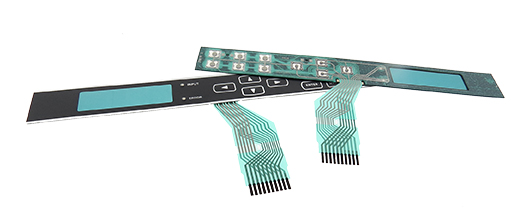How Membrane Switches Enhance Capability in Industrial and Customer Applications
How Membrane Switches Enhance Capability in Industrial and Customer Applications
Blog Article
The Ultimate Source on Membrane Layer Switches Over: Design, Functionality, and Applications
Membrane layer switches over serve as a fascinating crossway of design and functionality, playing a pivotal role in modern customer interfaces throughout various industries. As we explore the varied applications of membrane buttons, it becomes evident that their versatility and resilience are critical in environments varying from health care to customer electronics.

Understanding Membrane Layer Switches
Membrane switches are a sort of individual interface modern technology commonly utilized in different digital devices, identified by their thin, flexible style and functionality. These switches contain numerous layers that consist of graphic overlays, sticky layers, and circuitry, enabling a small and reliable user interface for customers. They can be found in home appliances, clinical gadgets, and industrial control panels, supplying a reputable method for customer communication.
One of the primary benefits of membrane switches is their capability to stand up to pollutants such as dust and moisture, making them appropriate for settings where durability is vital. Their inconspicuous layout enables smooth integration into different applications, while the adjustable graphic overlays improve customer experience by giving clear aesthetic feedback. In addition, membrane layer buttons can suit a selection of innovations, such as responsive responses and backlighting, more boosting their usability.
The manufacturing process for membrane layer switches usually includes screen die-cutting, lamination, and printing strategies, ensuring accuracy and consistency in production. Overall, membrane switches over stand for a flexible and efficient remedy for contemporary electronic tools, integrating performance with aesthetic charm in interface style.
Trick Components and Layout Aspects
A variety of vital elements and design components come together to produce an efficient membrane switch. At the core, the visuals overlay serves both practical and visual functions, supplying a straightforward interface while protecting interior parts from ecological elements. The selection of materials, commonly polyester or polycarbonate, affects resilience and responsive feedback.
Underneath the overlay, the glue layer makes sure the button adheres safely to the substratum, which can be glass, plastic, or metal. The spacer layer is critical, as it preserves the essential void between the overlay and the circuit layers, enabling for reliable actuation. Membrane Switches. Circuit traces, usually made from conductive ink or adhesive, are printed on an adaptable substratum, enabling electrical signals to be transferred when stress is applied
Design factors to consider also include the arrangement of tactile domes or embossing that give physical feedback to the user, boosting the total experience. In addition, the layout and spacing of the buttons have to be maximized for ease of use, making sure that customers can navigate the user interface intuitively. On the whole, these components and design elements work synergistically to produce a trusted, functional membrane switch customized to specific applications.
Functionality and Operation Mechanism
At the heart of effective capability for membrane layer switches exists their functional system, which facilitates user interaction via an easy yet more information effective style. These switches operate the concept of stress activation, where a customer uses force to a marked area of the button (Membrane Switches). This activity compresses the layers of the switch, finishing an electric circuit that sends a signal to the connected device
The building commonly consists of a leading graphic layer, an adhesive spacer layer, and a bottom circuit layer, which collectively form a durable user interface. When stress is used, the leading layer falls down versus the lower circuit layer, enabling conductive traces to connect. This layout not only allows clear tactile feedback but additionally makes certain resilience and reliability, as the switches are often immune to dirt and dampness.
In addition, the versatility of membrane switches over permits for integration with various innovations, including get redirected here LED signs and microcontrollers, improving their performance. By offering a structured interface that decreases mechanical wear, membrane layer changes continue to be a preferred selection in applications varying from consumer electronic devices to commercial equipment, making certain optimal performance and user satisfaction throughout diverse settings.
Kinds of Membrane Layer Switches

One more substantial category is illuminated membrane layer buttons, which include backlighting to improve visibility in low-light conditions. These buttons are frequently utilized in control panels and control panels where clear exposure is vital.
Moreover, there are customized membrane layer changes designed to satisfy particular dimensional, visual, and functional demands. These personalizations can consist of one-of-a-kind shapes, colors, and layouts, enabling seamless integration right into numerous devices.

Applications Throughout Numerous Industries
Just how do membrane switches improve performance throughout varied sectors? These versatile components are essential to countless applications, supplying structured interface and durable efficiency. In the medical field, membrane layer buttons play a critical function in tools such as analysis devices and patient tracking systems, where dependability and convenience of cleaning are paramount. Their capability to stand up to harsh environments makes them excellent for research laboratory tools and medical devices.
In the automotive sector, membrane buttons are generally made use of in dashboards and control board, providing intuitive controls that boost chauffeur safety and convenience. The consumer electronic devices industry additionally takes advantage of their customizable and lightweight features, allowing sleek layouts for mobile phones and home devices.
Moreover, membrane switches locate applications in industrial automation, where they contribute to effective equipment operation and tracking systems. Their resistance to dust and dampness makes sure performance popular conditions (Membrane Switches). Furthermore, the food and drink market utilizes membrane switches for devices control, where hygiene and resilience are critical
Conclusion
In final thought, membrane switches over stand for a crucial innovation in customer interface innovation, characterized by their unique design and performance. The flexibility of membrane changes promotes their application throughout varied markets, from medical gadgets to consumer electronic devices.
Membrane layer changes serve as an interesting intersection of layout and performance, playing an essential role in modern-day individual interfaces across different markets.Membrane buttons are a kind of customer interface innovation widely used in numerous digital devices, identified by their thin, adaptable layout and capability.At the heart of reliable functionality for membrane layer switches lies their operational mechanism, which helps with customer interaction via an easy yet reliable design. These buttons run on the principle of pressure activation, where an individual uses force to a marked area of the button.In conclusion, membrane layer switches over stand for a vital development in customer interface technology, defined by their distinct style and performance.
Report this page